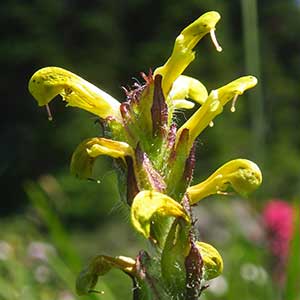Pedicularis procera
Pedicularis rainierensis
giant lousewort, Gray's lousewort
Mt. Rainier lousewort
basal 2–4, blade lanceolate, 150–250 x 80–120 mm, 2-pinnatifid, margins of adjacent lobes nonoverlapping, entire or serrate, surfaces glabrous or hirsute;
cauline 4–10, blade triangular to lanceolate, 60–300 x 5–90 mm, undivided or 1- or 2-pinnatifid, margins of adjacent lobes nonoverlapping, 2-serrate, surfaces glabrous.
basal 2–5, blade lanceolate, 40–80 x 3–20 mm, 2-pinnatifid, margins of adjacent lobes nonoverlapping or slightly overlapping distally, serrate to 2-serrate, surfaces glabrous;
cauline 2–6, blade lanceolate, 15–70 x 5–20 mm, 1- or 2-pinnatifid, margins of adjacent lobes nonoverlapping or slightly overlapping distally, serrate, surfaces glabrous.
simple, sometimes paniculate, 1–3, exceeding basal leaves, each 10–50-flowered;
bracts linear or narrowly lanceolate to subulate, 15–80 x 3–8 mm, undivided, proximal margins entire, distal entire or serrate, surfaces hispid to tomentose.
simple, 1–4, exceeding basal leaves, each 10–50-flowered;
bracts lanceolate or subulate to trullate, 10–15 x 1–2 mm, undivided or pinnatifid, proximal margins entire, distal serrate, surfaces glabrous or tomentose.
0–1 mm.
1–3.5 mm.
calyx 10–15 mm, hispid to hirsute, lobes 5, triangular, 4–7 mm, apex entire, ciliate;
corolla 22–30 mm, tube light yellow, greenish yellow, or light pink, 10–15 mm;
galea light yellow, greenish yellow, or light pink, with purple to red veins, 9–15 mm, beakless, margins entire medially, 1-toothed distally, apex arching over abaxial lip;
abaxial lip light yellow or light pink, with purple veins, 9–15 mm.
calyx 7.5–11 mm, hispid to tomentose, lobes 5, linear to narrowly triangular, 4–5 mm, apex entire, glabrous or ciliate;
corolla 16–19 mm, tube light or dark yellow, 8–10 mm;
galea light or dark yellow, 8–9 mm, beakless, margins entire medially and distally, apex arching beyond abaxial lip;
abaxial lip light or dark yellow, 4–5 mm.
= 32.
Pedicularis procera
Pedicularis rainierensis
Although Pedicularis grayi A. Nelson appears in older floras, the name is superfluous and illegitimate. Pedicularis procera Adams ex Steven 1822 is invalid.
Pedicularis procera is the tallest species of Pedicularis in North America. Because the leaves closely resemble those of P. bracteosa, smaller plants can be easily mistaken for this species.
(Discussion copyrighted by Flora of North America; reprinted with permission.)
Pedicularis rainierensis is known from Mt. Rainier and the Crystal Mountain area. The species is easily confused with P. bracteosa var. latifolia, which often occurs in the same meadows. While the sizes and shapes of their flowers are nearly indistinguishable, P. rainierensis is a much smaller plant with leaves only about three fourths the size, proximal leaf lobes less than one fifth the size, inflorescences about one half the length, and the number of flowers greatly reduced in comparison to those of P. bracteosa var. latifolia.
(Discussion copyrighted by Flora of North America; reprinted with permission.)


